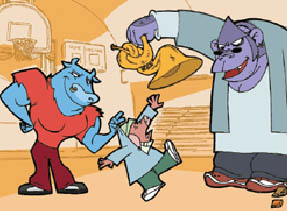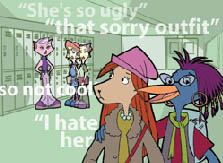Stop Bullying Now: An Interview with Dr. Dorothy Espelage
Dorothy Espelage
Professor of Educational Psychology, University of Illinois at Urbana-Champaign
 |
American View: How did you get interested in bullying research?
Dr. Espelage: Many people want to hear some wonderful story about me being victimized or being a bully, but there's really no story there. I studied a lot, and I was also an athlete, so I was what we call in the research a "liaison," which is someone who is able to negotiate between different peer groups. My family was in the Navy and moved a lot, so I was always the new girl in the classroom. Because I wasn't integrated into the peer groups that were already established, I didn't have much invested in going against the ringleader, so I found myself sticking up for kids who were being victimized.
That said, I became interested in youth violence in general when I studied child psychology at Indiana University. I took a research position in a federally funded project and came across the work of a Norwegian professor that discussed his notion of a very covert, subtle, low-level aggression called bullying. We found that the media tool we developed in our project for intervention in cases of severe physical aggression was not particularly effective against that level of violence, which was not very common, but it did have a positive impact in that the kids who participated in the intervention groups were less likely to bully. The research just took off from there. Because I wasn't sure if the European data were applicable to the situation in the U.S., I started to interview kids, and they started talking about how they bullied one another to become popular and to fit in, and I remember sitting there with my graduate student assistant and asking, "Do you hear what they're saying?" Because the existing literature in the field didn't support this; it said that aggressive children were rejected from their playgroups.
Q: Why do you think children bully each other?
Dr. Espelage: It is often thought that individual personality characteristics - lack of empathy toward a victim, anger management problems, ineffective coping strategies or poor emotion regulation skills, poor attachment to adults - place kids at risk to be bullies. We tend to think that there's just something wrong with that child and that's why they’re a bully. That's not true, however. Those characteristics only create a minimal risk. Problems arise when children come from environments that are violent, such as witnessing domestic violence in the home or being in a home where emotions aren't talked about, when they're not trained to regulate their emotions and solve problems, and they then go to a school where there’s no policy about bullying. The teachers bully one another, the teachers bully the students, and the principals bully the teachers. So that behavior is modeled in the school.
 |
Cartoons help educators and parents discuss bullying with children. (From the website of "Stop Bullying Now") |
The most powerful social agent around bullying is started and maintained in a peer group. Bullies are some of the most popular children across the world. Bullies are sometimes the most respected as athletes, and in many cases they have heightened social skills, so we actually like them. They're very skillful in using those personality characteristics to get other kids to go along with them. Remember when your mom said to you, "I don't like it when you hang out with that other child; I think that she's a bad influence." Your parents were right - kids do socialize each other in the areas of bullying, truancy, drugs and alcohol, and sex.
At the same time, bullying is, in some ways, the natural way to establish hierarchies within peer groups. I’m not going to get into evolutionary psychology, but the primate model is classic. Aggression within groups of primates looks very much like aggression within groups of middle school students.
Q: In the past, bullying was often seen as normal, as a rite of passage or something that children had to learn to endure. Do you think the attitude is changing?
Dr. Espelage: The Japanese audience is not any different than the audience in the Middle East or in the United States. People ask me, "Really, aren't you making too big a deal out of this? Isn’t it just part of growing up?" I appreciate the fact that someone comes forward and asks the question, because a lot of people in the room are thinking it. However, the use of drugs and alcohol is also very normative in adolescence, but we address and try to prevent that. With bullying, there are serious, long-term consequences for kids who are chronically victimized, and the kids who are chronic bullies are at great risk for becoming involved in the criminal system across the world. My perspective after 15 years of research in this area is that bullying should be seen not only as an interpersonal problem but also as a social problem, because bullies are at risk for becoming sexual harassers, violent in dating and marital relationships, and workplace bullies. The bully’s need for control and dominance does not stop when he or she gets a high school diploma.
 |
"Stop Bullying Now" was launched in 2003 by President Bush with the goal of preventing bullying across the U.S. (From the website of "Stop Bullying Now") |
Q: So how do you break the cycle?
Dr. Espelage: I'm a proponent in the United States of trying to do bullying prevention everywhere: in the school, in after-school programs, through faith organizations, through Girl Scouts and Boy Scouts, and working with pediatricians who do medical checkups with children. For example, pediatricians need to know how to ask a child if he has been victimized if he is saying he has a stomachache all the time. Children may be faking these illnesses to avoid a school situation where they feel unsafe. Trained pediatricians can help spot the problem. Despite the discussion of bullying by technology and text messaging, which is certainly happening, the highest prevalence of bullying is still in the school. So school is where school-wide, developmentally timed prevention programs should be conducted.
Through my programs and discussions with experts and stakeholders in Japan, I’ve told my audience here that I think there needs to be a shift in the thinking. Currently, Japan wants to look to the classroom teachers to do prevention of bullying. I observe that the teachers already have 35 to 40 students in the classroom and are not trained at the university to do basic classroom management. They tend to be extremely defensive and take on any kind of problem in the classroom as a failure on their part. While teacher training is important, teachers can't do it all by themselves. What is lacking in the Japanese system is mental health practitioners of some sort in the schools. "School counselors" here have maybe a weekend of training, but there is no system in Japan for training and placing mental health practitioners, like social workers, in the school. I think that needs to change. You need to come at the bullying problem from all directions, and everybody needs to play a role. What I say to the Japanese audience is that there has to be a national investment. Whoever has got the money and education has got to put some resources toward this or there's not going to be a sustainable prevention effort. There is no infrastructure in Japan now to make it reasonable to expect teachers to add this into their already busy week.
Q: What is the "Stop Bullying Now" campaign?
Dr. Espelage: It is the national campaign that President Bush signed in 2003 as a directive to the U.S. Department of Health and Human Services. The www.stopbullyingnow.org website is a clearinghouse of information written by experts so schools can download materials for use in student and parent education. I also hear about parents using it to talk about issues directly with their kids. The "webisodes" on the site were created through a number of focus groups with kids, who came up with a number of different ideas based on their experiences. Some Hollywood filmmakers were also involved, but it was very scientifically based. In the United States, 23 states now have some form of bullying policy definition. Those are usually the states where a child has committed suicide, but many states have not addressed the issue because they haven't had a critical incident that suggests this is a problem.
Q: Schoolchildren have access to a lot of communications technology, which has led to incidents and fears of so-called cyber-bullying. What is the situation?
Dr. Espelage: There is a lot of work to do, both in the United States and in Japan. About seven years ago, I started putting questions in my surveys about this trend. We already are developing a set of policies in the United States to manage this, such as requiring kids to turn in their cell phones at the beginning of school, a very simple solution. I haven’t seen that Japan is doing that, so kids are text-messaging throughout the day. In the United States, when we build new schools, we are designing certain areas where you cannot get a cell-phone signal. We monitor computer use in the schools. There's no reason that students should be making inappropriate blog posts about teachers or fellow students during school time. However, kids are very smart and have all these "underground websites," so the school has to be very sophisticated to get to them. We are spending a lot of time doing computer literacy and technology education for parents. We encourage parents to know the passwords that their kids are using on social networking sites and check to see what they are posting. There are other very simple measures, such as not allowing children to have a computer in their bedroom. We are just beginning to understand how to take down unhealthy websites, working closely with the CEOs of MySpace and FaceBook and other social-networking websites. We are very concerned about what's being posted. It's tricky, because there are freedom of speech issues, so where do you draw the line?
 |
In this episode, the popular girls in school bully a new student. (From the website of "Stop Bullying Now") |
Q: What areas do you see for international cooperation?
Dr. Espelage: Well, there has to be a concerted effort to train post-graduates in school counseling and school psychology. Many of our U.S. universities historically have offered joint programs in other countries, including training many practitioners in Taiwan and Hong Kong and a number of different countries in Central and South America. So I think that one way is for U.S. universities to partner with universities in Japan and South Korea to create master's programs. There are plenty of young individuals in both of these countries who would love to be able to get a master’s degree and work in the schools with kids. The international bullying research world is very small, and there are lots of opportunities to start having some conversations, because we are doing some very innovative things in the United States.
Q: What do you see as the main social negatives if the bullying problem is not addressed, and the main social benefits if bullying is prevented?
Dr. Espelage: Without addressing the problem, I think that rates of domestic violence, dating violence, and sexual violence will continue to increase. If it’s not addressed, there will continue to be suicides. Classroom teachers will become even more overwhelmed and continue to report mental health concerns. On the other hand, if bullying can be prevented, the benefits would be that kids would feel safer, the truancy rate would go down, kids who shut themselves in might come out, and teachers would be less stressed. Kids in schools that are safe tend to use drugs less, teachers are happier, and parents are usually happier. Ultimately, what we know is that when bullying is addressed, kids will perform better academically, and that's what both our governments want to hear. So I think that bullying should not be seen as an isolated outcome, but as integrally related to other problems that we see in schools.
Dr. Espelage received her PhD in counseling psychology at Indiana University in 1997. Her scholarship includes investigations of several health-related behaviors, including bullying and youth aggression, eating disorders in adolescents and young adults, and psychosocial adjustment of families of children managing chronic illness. At the invitation of the Department of State, she participated in a speaking tour of American Centers in South Korea and Japan in February 2008.
